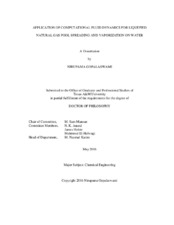| dc.contributor.advisor | Mannan, Sam | |
| dc.creator | Gopalaswami, Nirupama | |
| dc.date.accessioned | 2016-07-08T15:12:22Z | |
| dc.date.available | 2018-05-01T05:49:50Z | |
| dc.date.created | 2016-05 | |
| dc.date.issued | 2016-04-22 | |
| dc.date.submitted | May 2016 | |
| dc.identifier.uri | https://hdl.handle.net/1969.1/156950 | |
| dc.description.abstract | Liquefied Natural Gas (LNG) is a cryogenic liquid consisting predominantly of methane compressed to 1/600th of its gaseous volume for transportation. A release of LNG on water during marine operations can occur due to several factors. Upon release, a spreading liquid can form a pool with rapid vaporization, leading to the formation of a flammable vapor cloud. Safety analyses for the protection of the public and property involve the determination of consequences of such releases. The evaluation of consequences resulting from a spill of LNG on water involves the determination of the rate (vaporization rate/source-term) at which flammable hydrocarbon vapor is produced and the dynamics of the spreading pool. Two key parameters which affect pool spreading and vaporization, namely the heat flux to the LNG pool and the turbulence present within the cryogenic pool, are quantified separately through experiments. The heat flux from two different substrates comprised of water and ice is studied. The vaporization mass flux is directly influenced by the water temperature and the release rate. Similarly, the vaporization mass flux is directly influenced by the ice temperature when cryogenic liquid is released on ice. The experiment for quantification of turbulence present in cryogenic pool was performed using a high-speed camera. Flow visualization for turbulence quantification revealed the presence of wavy-structures called ‘thermals’ which catalyzed the vaporization process of cryogenic liquid released on water.
The results of key parameters study are implemented in CFD methodology to study the pool spreading and vaporization behavior. The CFD model is validated with an LNG experiment which simulates the LNG spill in space enclosed by two LNG ships during loading operations. The results of the research can be used for decision making in facility siting studies and emergency response planning for near shore/waterfront LNG facilities. | en |
| dc.format.mimetype | application/pdf | |
| dc.language.iso | en | |
| dc.subject | LNG | en |
| dc.subject | CFD | en |
| dc.subject | Consequence Analysis | en |
| dc.subject | Source Term | en |
| dc.subject | Process Safety | en |
| dc.title | Application of Computational Fluid Dynamics for Liquefied Natural Gas Pool Spreading and Vaporization on Water | en |
| dc.type | Thesis | en |
| thesis.degree.department | Chemical Engineering | en |
| thesis.degree.discipline | Chemical Engineering | en |
| thesis.degree.grantor | Texas A & M University | en |
| thesis.degree.name | Doctor of Philosophy | en |
| thesis.degree.level | Doctoral | en |
| dc.contributor.committeeMember | Anand, N.K | |
| dc.contributor.committeeMember | Holste, James | |
| dc.contributor.committeeMember | El-Halwagi, Mahmoud | |
| dc.type.material | text | en |
| dc.date.updated | 2016-07-08T15:12:22Z | |
| local.embargo.terms | 2018-05-01 | |
| local.etdauthor.orcid | 0000-0001-5387-9184 | |


